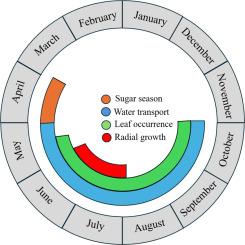解码糖枫的季节时钟:其物候事件的时间和顺序
IF 2.9
Q1 FORESTRY
引用次数: 0
摘要
生理过程的季节序列对理解枫碳分配策略和树液生产动态至关重要。对加拿大西蒙库什(QC)地区2018 - 2022年的糖槭物候事件进行了监测。利用安装在四棵成树上的雨量计和树木计测量了树液渗出、木质部水分输送和径向生长。利用modis衍生的归一化植被指数(NDVI)估算了研究点附近枫林的叶片物候特征。制糖季开始于3月下旬,结束于5月初,此时正值紧张局势推动的水运开始。糖季与融雪期和土壤含水量增加期相对应。在渗出液结束1周和3周后,当积雪消失和土壤温度开始上升时,分别观察到芽和完全叶膨胀。叶片展开后2周开始径向生长,8月初结束。11月上旬木质部水分运输停止,导致落叶。物候学在2021年暖春期间提前了三周。糖季与张力驱动的水分输送之间的同步性证实了汁液分泌的生理极限,这表明在冬季休眠后的补液时间窗内优化产量的重要性。在气候持续变暖的背景下,生产者可以更多地关注触发汁液季节的环境和生理信号,而不是仅仅依赖于汁液生产的历史日历。本文章由计算机程序翻译,如有差异,请以英文原文为准。

Decoding the seasonal clock of sugar maple: Timings and sequence of its phenological events
The seasonal sequence of physiological processes is essential to understand the strategies of carbon allocation and the dynamics of sap production in maple. We monitored the phenological events in sugar maple (Acer saccharum Marsh.) from 2018 to 2022 in Simoncouche (QC), Canada. We measured sap exudation, xylem water transport and radial growth using rain gauges and dendrometers installed on four adult trees. Leaf phenology was estimated with MODIS-derived Normalized Difference Vegetation Index (NDVI) in maple stands near the study site. The sugar season started in late March and ended in early May, at the onset of tension-driven water transport. The sugar season corresponded with the period of snowmelt and increase in soil water content. Budbreak and complete leaf expansion were observed one and three weeks after the ending of sap exudation, respectively, when the snow had disappeared and soil temperature started rising. Radial growth occurred two weeks after leaf expansion and ended in early August. The cessation of xylem water transport caused leaf fall in early November. Phenology advanced up to three weeks during the warm spring 2021. The synchronism between the sugar season and tension-driven water transport confirms the physiological limit for sap exudation, suggesting the importance of optimizing yield within the time window of rehydration after winter dormancy. In the context of ongoing climate warming, producers could benefit from paying more attention to the environmental and physiological signals triggering the sap season rather than relying solely on historical calendars of sap production.
求助全文
通过发布文献求助,成功后即可免费获取论文全文。
去求助
来源期刊

Trees, Forests and People
Economics, Econometrics and Finance-Economics, Econometrics and Finance (miscellaneous)
CiteScore
4.30
自引率
7.40%
发文量
172
审稿时长
56 days
 求助内容:
求助内容: 应助结果提醒方式:
应助结果提醒方式:


